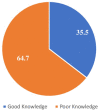Pregnant women's knowledge, attitude, and associated factors toward obstetric ultrasound in public hospitals, Ethiopia, 2021: Multi-centered cross-sectional study
- PMID: 35430932
- PMCID: PMC9019315
- DOI: 10.1177/17455057221091357
Pregnant women's knowledge, attitude, and associated factors toward obstetric ultrasound in public hospitals, Ethiopia, 2021: Multi-centered cross-sectional study
Abstract
Background: Obstetric ultrasound is a harmless, cheap, and noninvasive imaging modality that helps to scan a pregnant mother and delivers parents with a real-time image of the fetus. As the number of pregnancies rises globally, the demand for obstetric ultrasound becomes even more pressing.
Objectives: To assess pregnant women's knowledge, attitude, and associated factors toward obstetric ultrasound in public hospitals, Ethiopia.
Methods: Institutional based cross-sectional study was employed. Systematic random technique was used to select 419 pregnant women from 10 April 2021 through 2 June 2021. A structured questionnaire was used to collect data during a face-to-face interview. Then the data were coded, cleaned, and entered into Epidemiological data version (EPIDATA) 3.1 and exported to the statistical package for Social Science version 23.0 for analyses. Bivariate and multivariable logistic regression model was used to identify statistically significant associations between dependent and independent variables. The odds ratio at 95% confidence interval with p-value 0.05% was considered statistically significant.
Result: The majority of the study participants, 179 (42.8%), have ages ⩾ 25 years. Magnitude of having good knowledge and positive attitude of pregnant women toward obstetric ultrasound was 35.5% and 69.5%, respectively. Residence (adjusted odds ratio: 3.934; 95% confidence interval: 3.125-6.761), educational status (adjusted odds ratio: 3.614; 95% confidence interval: 1.986-5.964), and parity (adjusted odds ratio: 2.7621; 95% confidence interval: 1.68-3.275) were significantly associated with knowledge. Whereas exposure to obstetrical ultrasound in current pregnancy (adjusted odds ratio: 2.726; 95% confidence interval: 1.632-3.629), knowledge on obstetrical ultrasound (adjusted odds ratio: 3.92; 95% confidence interval: 1.324-3.120), and educational status (adjusted odds ratio: 2.84; 95% confidence interval: 1.337-3.381) were significantly associated with attitude.
Conclusion: The level of good knowledge and positive attitude toward obstetric ultrasound was 35.5% and 69.5%, respectively, and it can be improved with appropriate interventions like ensuring the practice of obstetric ultrasound scan to all antenatal women. Obstetric care providers at the antenatal care units should advice pregnant women for obstetric ultrasound scan as per World Health Organization recommendations of one obstetric ultrasound scan before 24 weeks of gestation.
Keywords: Ethiopia; obstetric ultrasound; pregnant women.
Conflict of interest statement
Figures
Similar articles
-
Knowledge, attitude, barriers, and associated factors of obstetric ultrasound among pregnant women in public hospitals, Ethiopia, 2022: a cross-sectional study.J Ultrasound. 2024 Mar;27(1):31-40. doi: 10.1007/s40477-023-00783-7. Epub 2023 May 10. J Ultrasound. 2024. PMID: 37162727 Free PMC article.
-
Pregnant women's knowledge, attitude, and practice toward physical exercise during pregnancy and its associated factors at Dessie town health institutions, Ethiopia.AJOG Glob Rep. 2024 Aug 13;4(4):100391. doi: 10.1016/j.xagr.2024.100391. eCollection 2024 Nov. AJOG Glob Rep. 2024. PMID: 39296603 Free PMC article.
-
Assessment of knowledge and attitude of pregnant women towards antenatal ultrasound in University of Gondar comprehensive specialized hospital at antenatal care clinic, Northwest Ethiopia.PLoS One. 2023 Nov 8;18(11):e0292496. doi: 10.1371/journal.pone.0292496. eCollection 2023. PLoS One. 2023. PMID: 37939118 Free PMC article.
-
WOMEN's Knowledge of Obstetric Danger signs in Ethiopia (WOMEN's KODE):a systematic review and meta-analysis.Syst Rev. 2019 Feb 25;8(1):63. doi: 10.1186/s13643-019-0979-7. Syst Rev. 2019. PMID: 30803443 Free PMC article.
-
Knowledge, attitude and practice towards antenatal physical exercise among pregnant women in Ethiopia: A systematic review and meta-analysis.PLoS One. 2023 Dec 14;18(12):e0295275. doi: 10.1371/journal.pone.0295275. eCollection 2023. PLoS One. 2023. PMID: 38096224 Free PMC article.
Cited by
-
Pregnant Women's Knowledge and Expectations about Prenatal Ultrasound: A Cross-Sectional Study.Rwanda J Med Health Sci. 2023 Nov 30;6(3):346-354. doi: 10.4314/rjmhs.v6i3.8. eCollection 2023 Nov. Rwanda J Med Health Sci. 2023. PMID: 40568646 Free PMC article.
-
Assessment of Pregnant Women's Knowledge and Perceptions of Antenatal Ultrasound in Saudi Arabia.Healthcare (Basel). 2024 Jul 15;12(14):1409. doi: 10.3390/healthcare12141409. Healthcare (Basel). 2024. PMID: 39057552 Free PMC article.
-
Prenatal ultrasound utilization and associated factors among pregnant women attending antenatal care in south Wollo zone public hospitals, north east, Ethiopia, 2023.Front Digit Health. 2025 Apr 28;7:1547547. doi: 10.3389/fdgth.2025.1547547. eCollection 2025. Front Digit Health. 2025. PMID: 40357236 Free PMC article.
-
Exploring measurement tools used to assess knowledge, attitudes, and perceptions of pregnant women toward prenatal screening: A systematic review.Womens Health (Lond). 2024 Jan-Dec;20:17455057241273557. doi: 10.1177/17455057241273557. Womens Health (Lond). 2024. PMID: 39206551 Free PMC article.
-
Knowledge, attitudes, and concerns regarding antenatal pregnancy screening among women in Hail city and its surrounding provinces: A cross-sectional survey study.J Family Med Prim Care. 2025 May;14(5):2041-2047. doi: 10.4103/jfmpc.jfmpc_1914_24. Epub 2025 May 31. J Family Med Prim Care. 2025. PMID: 40547743 Free PMC article.
References
-
- Dasan TA, Singh S, Koratagere RS, et al.. Knowledge and attitude of antenatal women towards routine ultrasound screening in pregnancy at a tertiary institution in Bengaluru. Int J Anat 2016; 5(4): 11–14.
-
- World Health Organization (WHO). WHO recommendations on antenatal care for a positive pregnancy experience. Geneva: WHO, 2016. - PubMed
-
- Geerts LT, Brand EJ, Theron GB. Routine obstetric ultrasound examinations in South Africa: cost and effect on perinatal outcome—a prospective randomised controlled trial. Br J Obstet Gynaecol 1996; 103(6): 501–507. - PubMed
-
- Croft MS, Desai G, Seed PT, et al.. Application of obstetric ultrasound to determine the most suitable parameters for the aging of formalin-fixed human fetuses using manual measurements. Clin Anat 1999; 12(2): 84–93. - PubMed
Publication types
MeSH terms
LinkOut - more resources
Full Text Sources
Research Materials
Miscellaneous



